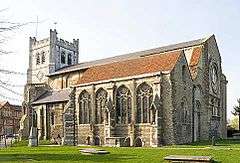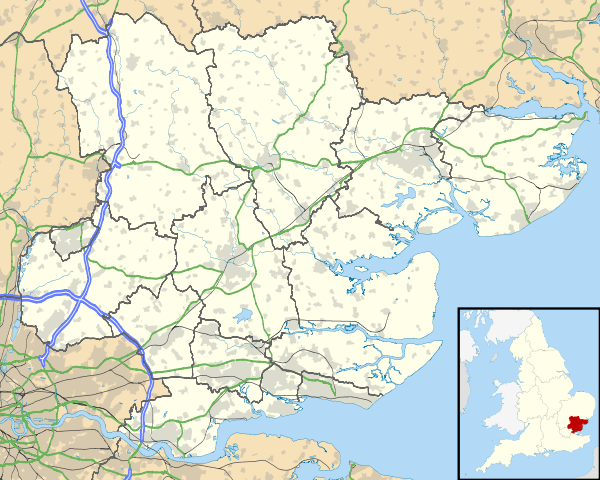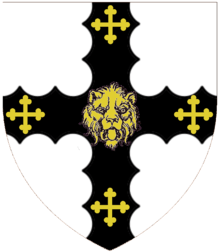Waltham Abbey (parish)
Waltham Abbey is a civil parish in Epping Forest District in Essex, England. Located approximately 14 miles (23 km) north-northeast of central London and adjacent to the Greater London boundary, it is a partly urbanised parish with large sections of open land in the Metropolitan Green Belt. Waltham Abbey is a recent renaming of the ancient parish of Waltham Holy Cross. Aside from the town of Waltham Abbey, it includes the hamlets of Claverhambury, Fishers Green, Holyfield, Sewardstone and Upshire, and the village of High Beach. The local council is Waltham Abbey Town Council.
| Waltham Abbey | |
|---|---|
 The parish is named after the church of Waltham Abbey | |
 Waltham Abbey Location within Essex | |
| Area | 16.3746 sq mi (42.410 km2) |
| Population | 21,149 (2011)[1] |
| • Density | 1,292/sq mi (499/km2) |
| OS grid reference | TL403005 |
| • London | 14 mi (23 km) SSW |
| Civil parish |
|
| District | |
| Shire county | |
| Region | |
| Country | England |
| Sovereign state | United Kingdom |
| Post town | WALTHAM ABBEY |
| Postcode district | EN9 |
| Post town | LONDON |
| Postcode district | E4 |
| Post town | LOUGHTON |
| Postcode district | IG10 |
| Dialling code | 01992 020 |
| Police | Essex |
| Fire | Essex |
| Ambulance | East of England |
| UK Parliament | |
| Website | walthamabbey-tc |
History
Waltham Holy Cross was an ancient parish in the Waltham hundred of Essex.[2] The parish adopted the Public Health Act 1848 in 1850 which created the Waltham Holy Cross local government district and a local board of health. In 1894 this district became Waltham Holy Cross Urban District, governed by an urban district council. The parish ceased to have any role in local government, aside from election of the board of guardians. After 1930 as a designated urban parish it had only nominal existence.
The parish was within the Metropolitan Police District and part of the review area of the Royal Commission on Local Government in Greater London; however, it did not form part of the proposed Greater London area,[3] because it was entirely within the Metropolitan Green Belt and had limited connection to the London built-up area.[4]
On 1 April 1974 the Waltham Holy Cross Urban District was abolished and combined with other local government districts to form the Epping Forest District. The urban district council was replaced with Epping Forest District Council. A limited number of former boroughs and urban districts were permitted to retain limited local government powers as successor parishes. Waltham Holy Cross civil parish gained a parish council and became used for local government again.[5] The parish was initially known as Waltham Holy Cross, but by resolution of the new parish council it was renamed Waltham Abbey and the status of a town was adopted, with the parish council becoming Waltham Abbey Town Council.
The Enfield Island Village area was transferred from the parish, to the unparished area of Enfield in Greater London in 1994.[6] The parish ceased to be part of the Metropolitan Police District in 2000 and came within the area of Essex Police that year.
Government
The local council is Waltham Abbey Town Council. The town hall is located on Highbridge Street in the town of Waltham Abbey. There are eleven councillors elected from five wards. The wards are High Beech (2 councillors), Honey Lane (3 councillors), North East (2 councillors), Paternoster (2 councillors), and South West (2 councillors).[7]
Geography
The civil parish is 16.3746 square miles (42.410 km2). It is located approximately 14 miles (23 km) north-northeast of central London and is adjacent to the Greater London boundary to the south. The M25 motorway runs through the parish east–west, splitting it into two approximately equal parts. The town of Waltham Abbey is located immediately to the north of the motorway. The northwest of the parish contains part of the Lee Valley Park. Most of the parish, and the majority of its population, are within the Waltham Abbey post town of the EN postcode area. However, lightly populated parts to the south are within the Loughton post town of the IG postcode area, and the Sewardstone and Gilwell Park areas to the southwest are within the E postcode area of the London post town.
The main settlement in the parish is the town of Waltham Abbey, and the other smaller settlements are the hamlets of Claverhambury, Fishers Green, Holyfield, High Beach, Sewardstone and Upshire.
Claverhambury consists of approximately 15 homes and farms by two woods, Deerpark Wood and Stockings Grove, to the north-east of the town centre. Its bounds are the eastern slopes of Galley Hill. The western side of this hilltop is wooded. It is directly south of Epping Long Green, a tall ridge topped by the Stort Valley Way[8] footpath between the towns of Epping and Harlow.[9]
Fishers Green is a locality 1 mile (1.6 km) north of the town of Waltham Abbey on the B194 road on the section known as the Crooked Mile.
Holyfield Lake is home to the Fishers Green Sailing Club, offering a beautiful setting with tiny islands dotting the 180-acre tree-lined lake, making sailing all the more challenging and interesting.
Holyfield consists of approximately 11 homes and farms and is mostly on the western slopes of Monkham's Hill, near the top of which is situated Monkham's Hall.[10] Seven buildings in the hamlet are architecturally listed.[11] In the west are plant nurseries above lakes of the River Lea, and an arboretum and tree nursery separate the hamlet from the town to the south. It is located at grid reference grid reference TL385035.
Transport
There are no railway lines or stations within the parish, although there are several located nearby. The nearest stations are Chingford, half a mile south of the parish boundary; Loughton, one mile to the east; and Waltham Cross, half a mile to the west.
Arms
 |
|
References
- http://www.neighbourhood.statistics.gov.uk/dissemination/LeadTableView.do?a=7&b=11130111&c=waltham+abbey&d=16&e=61&g=6424994&i=1001x1003x1032x1004&m=0&r=1&s=1378116807630&enc=1&dsFamilyId=2491
- http://www.visionofbritain.org.uk/unit/10248310
- Royal Commission on Local Government in Greater London: 1957–1960: Report, 1960, HMSO
- Sharpe, LJ (1961). The Report of The Royal Commission on Local Government in Greater London.
- The Local Government (Successor Parishes) Order 1973 (1973 No. 1110)
- http://www.legislation.gov.uk/uksi/1993/1141/made
- http://www.walthamabbey-tc.gov.uk/members/ward_members_list.php
- Stort Valley Way Retrieved 1 December 2012
- Ordnance survey website
- Winters, William. "The history of the ancient parish of Waltham Abbey, or Holy Cross". Retrieved 3 June 2013.
- Ordnance Survey map, courtesy of English Heritage
- "Civic Heraldry of England". Robert Young. Retrieved 13 March 2019.